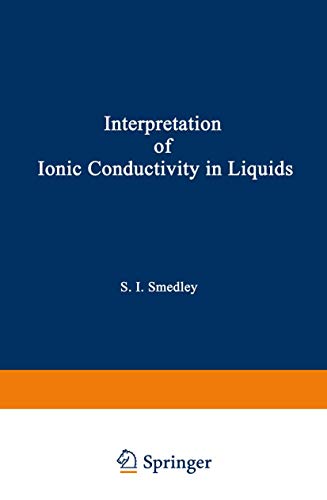Articoli correlati a The Interpretation of Ionic Conductivity in Liquids

The phenomenon of electrical conductance in liquids is of great impor tance to the technologist, as well as to the theoretical scientist. A glance at Chemical Abstracts will reveal that electrical conductivity can be used as an analytical tool for such diverse substances as concrete and suntan lotion as well as a tool for elucidating the dynamics of molecules in simple liquids. It is a phenomenon that is relatively easily measured, which explains the great diversity of conductance studies that span a range of experimental conditions unequalled in the study of nonequilibrium phenomena. It is clearly impossible for one book, notwithstanding the ability of one author, to cope with so much information or to cover even a significant fraction of the literature on this subject. However, I believe it is possible to bring together in one monograph the mainstream ideas on the interpretation of the phenomenon in relatively simple systems. It is hoped that this book will achieve this result and will provide a concise and coherent account of the interpretation of ionic conductivity in dilute electrolyte solutions, concentrated solutions, low-temperature or glass-forming molten salts, ionic melts, molecular fluids, and fluids of geological and industrial inter est. Most of these topics have been discussed in other books and review articles, but to the best of my knowledge they have not been gathered together in a single monograph.
Le informazioni nella sezione "Riassunto" possono far riferimento a edizioni diverse di questo titolo.
Contenuti:
1. Introduction and Definitions.- 1.1. Introduction.- 1.2. Electrical Conductivity.- 1.3. Diffusion and Viscosity.- 1.3.1. The Diffusion Coefficient.- 1.3.2. Viscosity.- 1.4. The Stokes-Einstein and Nernst-Einstein Relations.- 1.4.1. The Stokes-Einstein Relation.- 1.4.2. The Nernst-Einstein Relation.- 1.4.3. The Walden Product.- 2. Ionic Conductivity in Dilute Electrolyte Solutions.- 2.1. Concentration Dependence of Conductivity of Dilute Electrolyte Solutions—Introduction.- 2.1.1. Derivation of the Conductance Equations.- 2.1.2. The Relaxation Effect.- 2.1.3. The Electrophoretic Effect.- 2.1.4. Conductivity Equations for Nonassociated Electrolytes.- 2.1.5. Conductivity Equations for Associated Electrolytes.- 2.1.6. Test of the Conductivity Equation.- 2.2. The Concentration Dependence of Conductivity at High Pressure and Moderate Temperatures.- 2.3. The Concentration Dependence of Conductivity at High Pressure and Temperature.- 2.4. The Effect of Pressure on Electrical Conductivity at Ambient Temperatures.- 2.4.1. Hydrogen-Bonded Solvents.- 2.4.2. Neutral Solvents.- 2.5. The Effect of Pressure on the Conductivity of Electrolyte Solutions at High Temperatures and Pressures.- 2.6. Excess H+ and OH- Mobility in Aqueous Solutions.- 2.7. The Limiting Ionic Conductivity of Ions in Solution.- 2.7.1. The Molecular Hydrodynamic Approach.- 2.7.2. The Transition State Theory.- 3. Ionic Conductivity in Low-Temperature Molten Salts and Concentrated Solutions.- 3.1. The Transition from Dilute Solutions to Molten Salts.- 3.2. Composition Dependence of Conductance in Concentrated Solutions and Low-Temperature Molten Salts.- 3.2.1. The Dilute Solution Approach.- 3.2.2. The Molten Salt Approach.- 3.3. Temperature and Pressure Dependence of Conductance in Concentrated Solutions and Low-Temperature Molten Salts.- 3.4. Electrical Relaxation in Glass-Forming Molten Salts.- 4. Electrical Conductivity in Ionic Liquids at High Temperatures.- 4.1. The Temperature and Pressure Dependence of Electrical Conductivity in Ionic Liquids.- 4.2. Theories for Electrical Conductivity in Ionic Melts.- 4.2.1. Transition State Theory.- 4.2.2. The Hole Model of Liquids.- 4.2.3. The Theory of Significant Liquid Structures.- 4.2.4. The Kirkwood-Rice-Allnatt Kinetic Theory of Electrical Conductance.- 4.2.5. The “Free Ion” Theory of Conductance of Barton and Speedy.- 4.2.6. Other Theories.- 5. Ionic Conductivity in Molecular Liquids and Partially Ionized Molten Salts.- 5.1. Introduction.- 5.2. The Temperature and Pressure Dependence of Conductivity.- 5.3. Conclusions.- 6. Electrical Conductivity in Liquids of Geological and Industrial Interest.- 6.1. Geological Liquids.- 6.1.1. Seawater.- 6.1.2. Geothermal Waters.- 6.1.3. Silicate Melts and Magmas.- 6.2. Industrial Electrolytes.- 6.2.1. Aqueous Industrial Electrolytes.- 6.2.2. Nonaqueous Electrolyte Solutions.- 6.2.3. Molten Salt Electrolytes.- References.
Product Description:
Book by Smedley Stuart I
Le informazioni nella sezione "Su questo libro" possono far riferimento a edizioni diverse di questo titolo.
- EditorePlenum Pub Corp
- Data di pubblicazione1980
- ISBN 10 0306405296
- ISBN 13 9780306405297
- RilegaturaCopertina rigida
- Numero edizione1
- Numero di pagine196
Compra usato
Condizioni: buonoFormer library book; Missing dust... Scopri di più su questo articolo
EUR 14,31
Spese di spedizione:
GRATIS
In U.S.A.
I migliori risultati di ricerca su AbeBooks
Interpretation of Ionic Conductivity in Liquids
Editore:
Springer
(1980)
ISBN 10: 0306405296
ISBN 13: 9780306405297
Antico o usato
Rilegato
Quantità: 1
Da:
Valutazione libreria
Descrizione libro Hardcover. Condizione: Good. No Jacket. Former library book; Missing dust jacket; Pages can have notes/highlighting. Spine may show signs of wear. ~ ThriftBooks: Read More, Spend Less 1. Codice articolo G0306405296I3N11
Compra usato
EUR 14,31
Convertire valuta

